- 1Department of Mathematics, College of Science, Jazan University, Jazan, Saudi Arabia
- 2Department of Computer Science, Prince Sattam Bin Abdulaziz University, Al-Kharj, Saudi Arabia
- 3Faculty of Computing and Information Technology, King Abdulaziz University, Jeddah, Saudi Arabia
- 4Independent Researcher, Eskisehir, Türkiye
Some new types of truncated M-fractional exact soliton solutions of the two important quantum plasma physics models, extended quantum Zakharov–Kuznetsov and extended quantum nonlinear Zakharov–Kuznetsov, are successfully achieved by applying the
1 Introduction
Many naturally occurring phenomena in various areas of science and engineering, like plasma, acoustics, chemistry, biology, and many others, are expressed in the form of fractional nonlinear partial differential models (FNLPDMs). Both exact and approximate results have been obtained by applying different techniques in the literature. For example, the efficient
Currently, exact solutions, especially soliton-like solutions, have gained much importance because this has become a special topic in nonlinear science. Soliton theory has gained importance because of the exceptional properties of soliton. A soliton maintains its shape and velocity after interaction and stability. Solitons have different forms, like dark, periodic, singular, bright, dark-bright, kink, antikink, and many others.
We utilize three distinct techniques to obtain the exact soliton solutions in our research: the
Our research models are the extended quantum nonlinear Zakharov–Kuznetsov model and the modified quantum nonlinear Zakharov–Kuznetsov model, along with a truncated M-fractional derivative. These are the important models in mathematical physics, quantum physics, and plasma physics. Both models are used to explain the ion-acoustic waves in magnetized plasma with cold ions and hot isothermal electrons, as well as in electron-positron-ion magnetoplasmas in the presence of a uniform magnetic field.
Consider the (3 + 1)-dimensional truncated M-fractional extended quantum nonlinear Zakharov–Kuznetsov model [24].
This model is used for ion-acoustic waves in a magnetized plasma containing cold ions and hot isothermal electrons. Different techniques have been used for Equation 1 without fractional derivatives to obtain the exact wave solutions, such as soliton solutions, and some other wave solutions have been achieved by applying the extended simplest equation technique [25]. Periodic and traveling wave solutions have been attained by using bifurcation theory [26]. Many exact wave solutions have been gained by utilizing the sine-Gordon expansion technique and the
Consider the (3 + 1)-dimensional truncated M-fractional modified quantum nonlinear Zakharov–Kuznetsov model [24]:
Equation 2 has been solved by different techniques in the literature: various soliton wave solutions have been gained by using the modified Sardar sub-equation method [30], and new kinds of soliton solutions, including the 1-soliton solution, have been obtained by applying the improved
The basic purpose of our research work is to determine the novel exact soliton solutions to the truncated M-fractional extended quantum nonlinear Zakharov–Kuznetsov model and the truncated M-fractional modified quantum nonlinear Zakharov–Kuznetsov model by applying the
The motivation of this paper is to determine the new types of exact soliton solutions of the extended quantum nonlinear Zakharov–Kuznetsov model and the modified quantum nonlinear Zakharov–Kuznetsov model, along with a truncated M-fractional derivative. The effect of this derivative is also explained. Truncated M-fractional derivatives fulfill the characteristics of both integer and fractional derivatives. This definition of derivative provides more valuable results than other definitions. In addition, this definition of a fractional derivative provides results that are close to the numerical results. The obtained solutions are useful in the many areas of mathematical physics, especially quantum physics and plasma physics, to explain the ion-acoustic waves in magnetized plasma having cold ions and hot isothermal electrons, as well as in electron-positron-ion magnetoplasmas in the presence of a uniform magnetic field.
First, all three utilized techniques convert the nonlinear fractional partial differential equations into nonlinear ordinary differential equations (ODEs) and then solve the obtained ODEs. The methods explore the different types of solutions. The
The paper consists of the following sections:
Section 2 provides a complete description of the utilized techniques.
Section 3 addresses the mathematical treatments of our concerned models.
Section 4 addresses the applications of the techniques to obtain the exact soliton solutions of the extended quantum nonlinear Zakharov–Kuznetsov model.
Section 5 addresses the applications of the techniques to obtain the exact soliton solutions of the modified quantum nonlinear Zakharov–Kuznetsov model.
Section 6 provides graphical representations of some of the solutions.
Section 7 provides the physical analysis of the solutions.
Section 8 discusses the results.
Section 9 is the conclusion of our research work.
1.1 Truncated M-fractional derivative (TMFD)
Definition: consider
here,
Properties: Consider that a, b
The truncated M-fractional derivative (TMD) is a fractional derivative that was introduced by Sousa and de Oliveira [36]. This derivative has expunged the obstacles with the existing derivatives. This definition of derivative is used for various models, such as the Shynaray-IIA equation [37], the Cahn–Allen equation [38], and many more.
2 Techniques
2.1
Some of the main points of this method are given as:
Considering a nonlinear PDE:
Equation 3 reduces into a nonlinear ODE:
By applying the given wave transformations:
Assuming the results for Equation 4 are [39–42]:
Here,
Inserting
After obtaining solutions, one can get exact solitons for Equation 3.
2.2 Improved
We provide the main steps of this technique here [43].
Step 1. Let’s take a nonlinear fractional PDE.
Step 2. Consider the following transformation:
where
Step 3. Consider the solutions of Equation 9 shown as
In Equation 10,
The function
where
Step 4. Assume Equation (11), we have solutions shown as:
Case 1: if
Case 2: if
Case 3: if
Case 4: if
Here,
Step 5. Substitute Equation 10 and Equation 11 into Equation 9 and collect the coefficients of every order of
Step 6. Solve the above system of algebraic equations with the Mathematica tool.
Step 7. By putting the solutions obtained above into Equation 10, we get the trigonometric, hyperbolic trigonometric, and rational function soliton type results of the nonlinear partial differential (NLPD) equation shown in Equation 7.
2.3 Sardar sub-equation technique
This technique [44] considers the nonlinear fractional PDE:
where
yields the following form of a nonlinear ordinary differential equation (NLODE):
Consider a solution of Equation 12 in the form:
where
in which
Next, we proceed by first substituting Equations 13 and 14 into Equation 12 and sum the
Case 1: if
where
Case 2: if
where
Case 3: if
where
Case 4: if
where
The advantage of this technique is that it provides many different kinds of solitons, such as dark, bright, singular, periodic singular, combined dark-singular, and combined dark-bright solitons. This method has simple calculations, high accuracy, and low computational effort and provides a variety of solution forms.
3 Mathematical analysis of concerning models
3.1 Extended QNLZK model
Considering the following wave transformation:
where a, b, c, and
By applying the homogenous balance technique to Equation 16, we get
3.2 Modified QNLZK model
By applying the transformation given in Equation 15 to Equation 2, we attain the following nonlinear ODE after one-time integration and neglecting the integration constant:
Consider the new transformation to retrieve the closed-form solutions:
By using Equation 18 in Equation 17, we gain
By balancing the
4 Exact soliton solutions of the extended QNLZK model
4.1 By the
Equation 5 transforms into given form for
where
Set 1.
where “a” is given in Equation 21.
Set 2.
where “a” is given in Equation 21.
4.2 By the improved
For
Here,
By substituting Equation 23 and Equation 11 into Equation 16, we can collect the coefficients of each power of
Set 1.
where “a” and
where
Set 2.
where “a” and
where
4.3 By the Sardar sub-equation technique
For
Here,
Set 1.
Case 1:
Case 2:
Case 3:
Case 4:
Set 2.
Case 1:
Case 2:
Case 3:
Case 4:
5 Exact soliton solutions of the modified QNLZK model
5.1 By
Equation 5 transforms into the given form for
where
Set
5.2 By improved
For
Here,
Substitute Equation 30 and Equation 11 into Equation 19 and collect the coefficients of each power of
Set
where
where
5.3 By the Sardar sub-equation technique
For
where
Set 1.
Case 1:
Case 2:
where
Set 2.
Case 3:
Case 4:
where
6 Graphical representation
Here, we represent some of our solutions with two-dimensional, three-dimensional, and contour graphs. The effect of the fractional derivative is also shown by graphs for
7 Physical explanation
Here, we present the physical significance of the abovementioned solutions to the truncated M-fractional extended nonlinear quantum Zakharov–Kuznetsov model (ENLQZKE) and the modified nonlinear quantum Zakharov–Kuznetsov model (MNLQZKE) by plotting these solutions in 2-D at different time levels and different values of
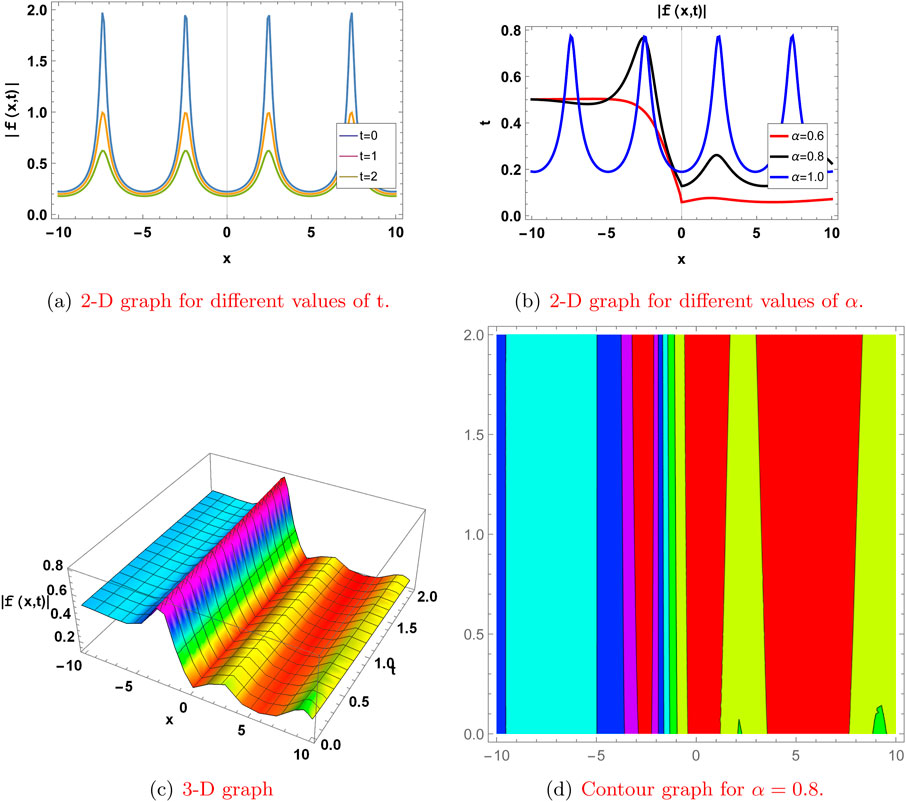
Figure 1. Graph for
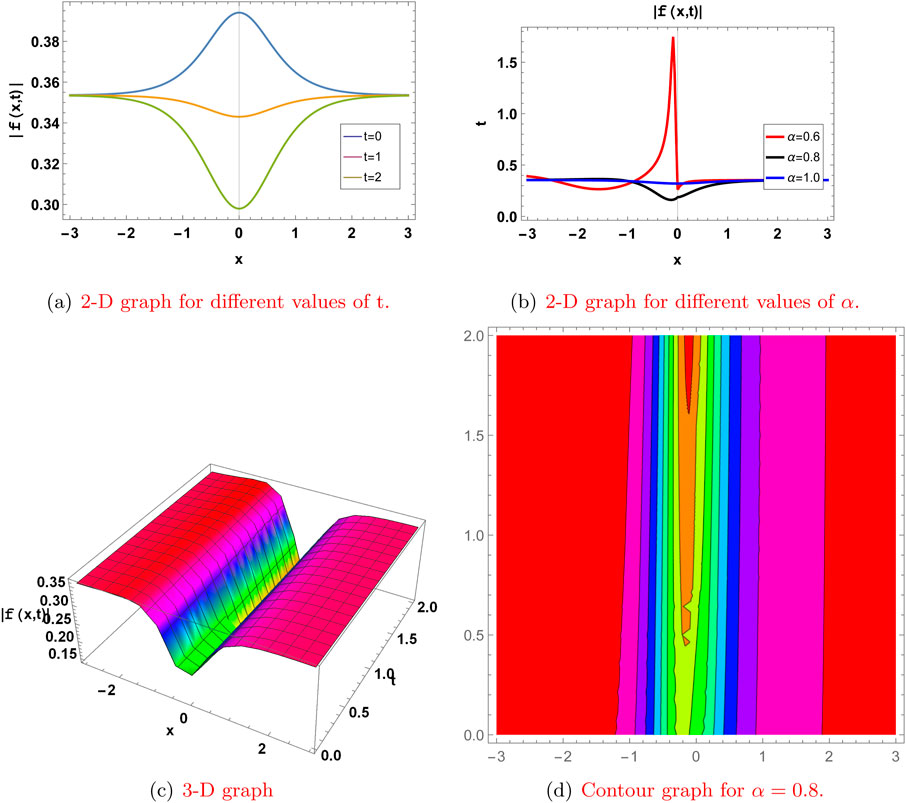
Figure 2. Graph for the
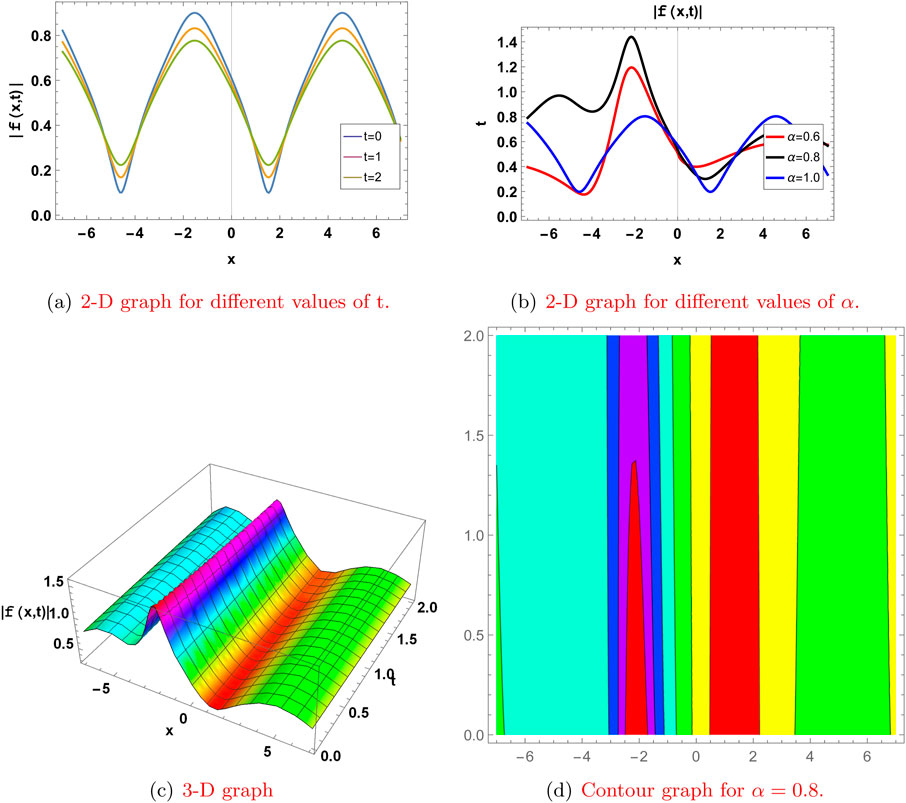
Figure 3. Graph for
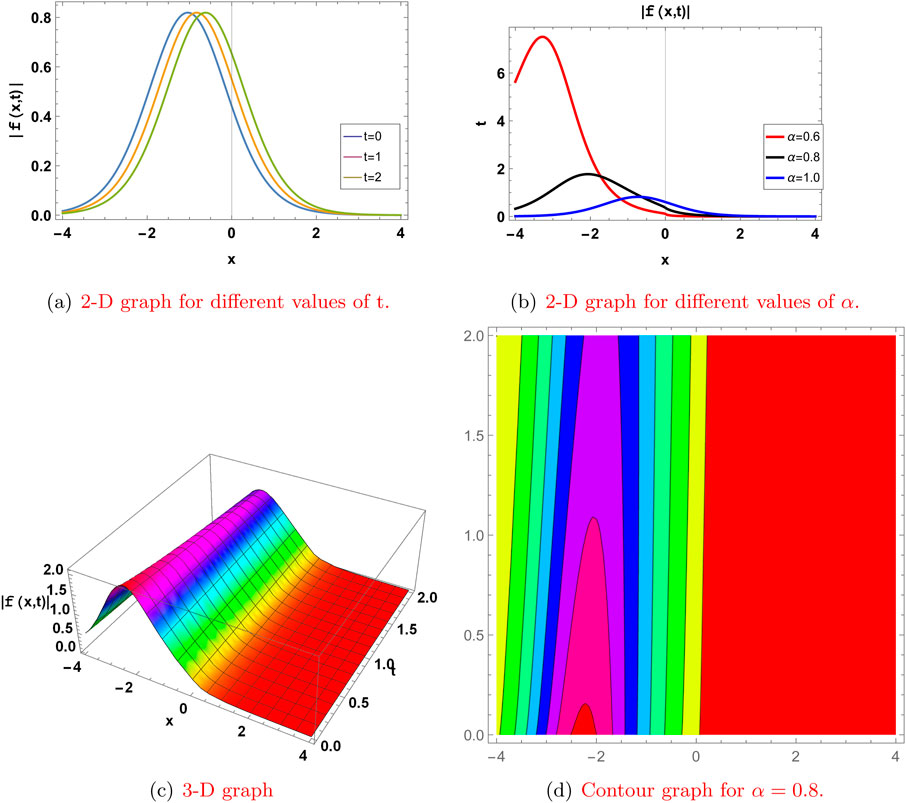
Figure 4. Graph for the
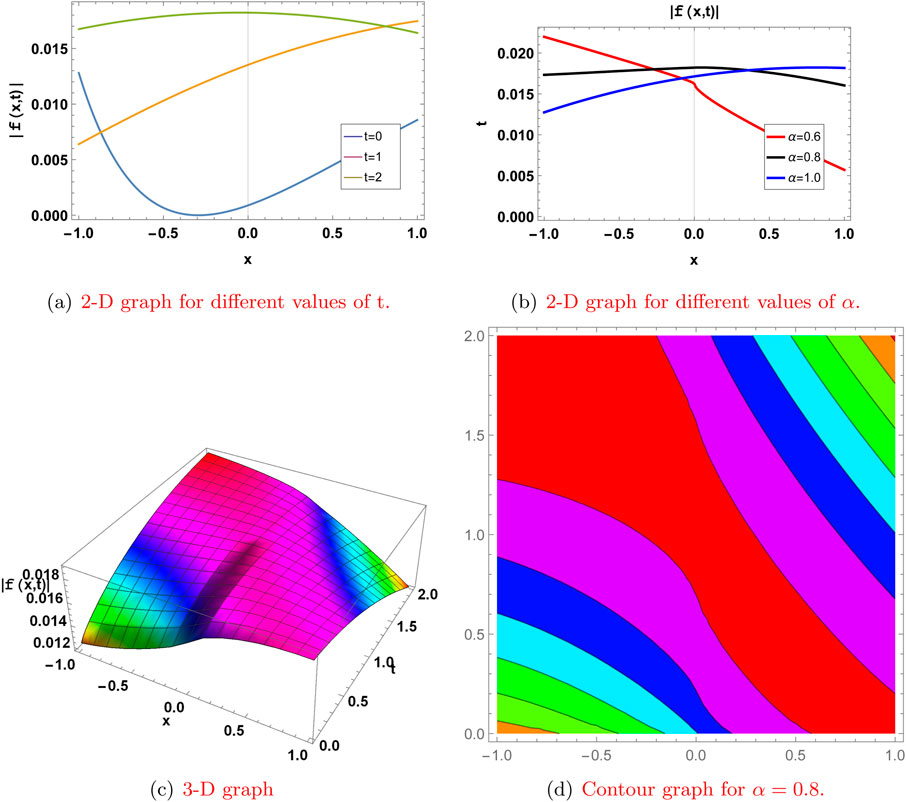
Figure 5. Graph for
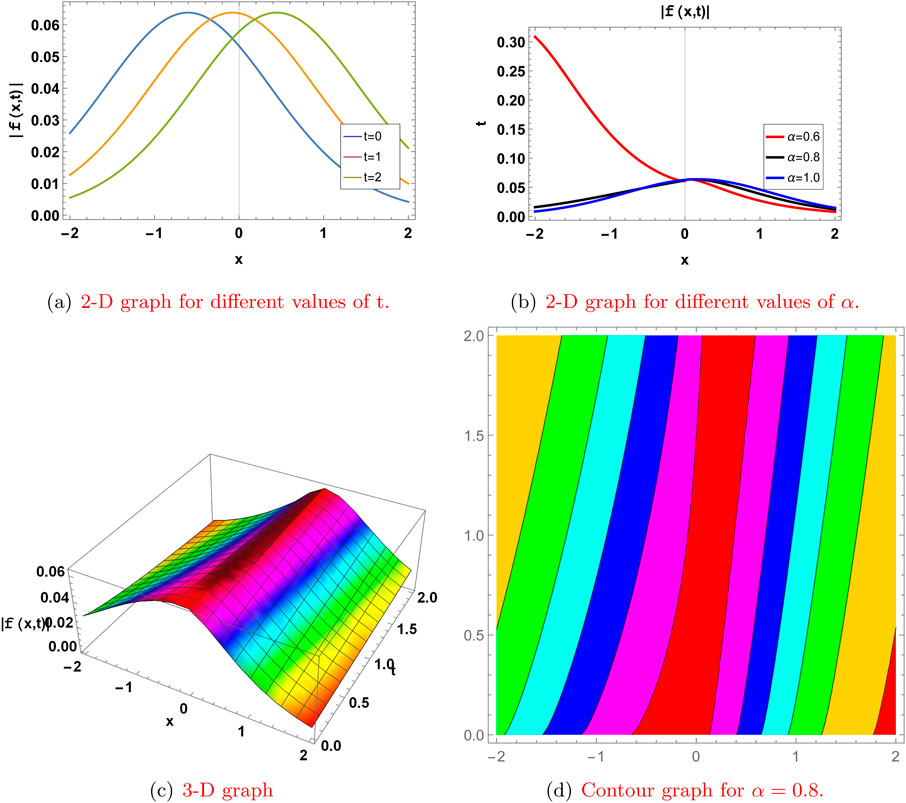
Figure 6. Graph for
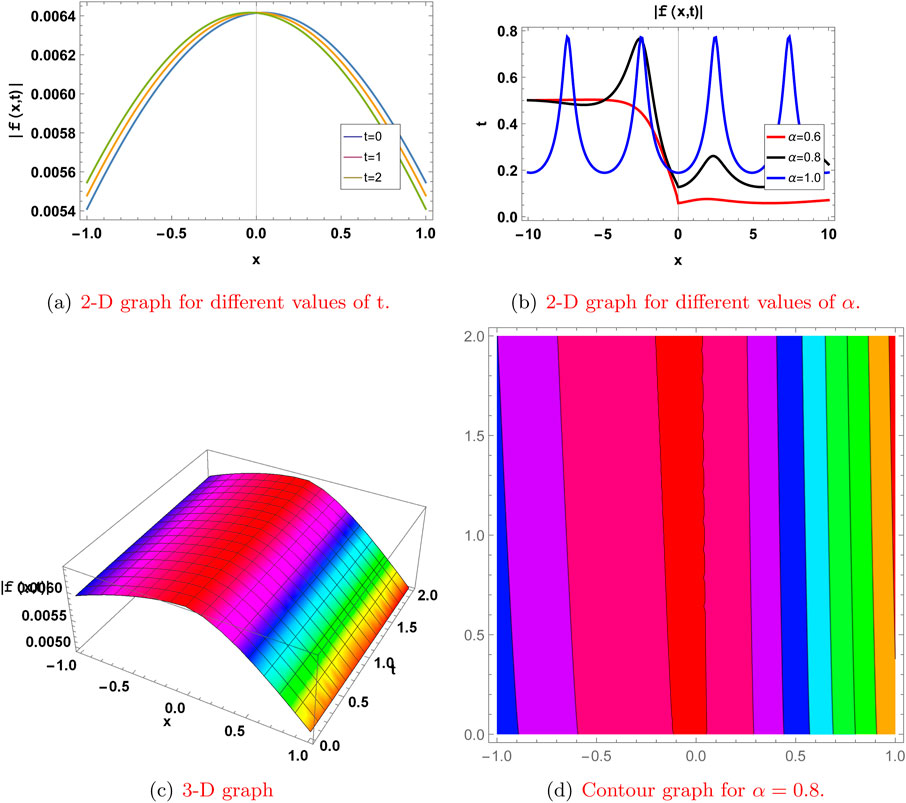
Figure 7. Graph for the
The results of this work encourage further future discussion in various branches of science, especially in quantum plasma physics.
8 Results and discussion
Here, we will compare the existing results and the results we obtained from the concerned model. Different techniques have been used for nonlinear extended and modified quantum Zakharov–Kuznetsov equations without fractional derivatives to obtain the exact wave solutions. Some solitary wave solutions are obtained in [24]; soliton and some other wave solutions have been achieved by applying the extended simplest equation technique [25]; periodic and traveling wave solutions have been attained by using bifurcation theory [26]. Many exact wave solutions have been gained by utilizing the sine-Gordon expansion technique and the
9 Conclusion
We have succeeded in attaining novel exact soliton solutions to the extended nonlinear quantum Zakharov–Kuznetsov model (ENLQZKE) and the modified nonlinear quantum Zakharov–Kuznetsov model (MNLQZKE) with a truncated M-fractional derivative. For this purpose, we utilize the
Data availability statement
The original contributions presented in the study are included in the article/supplementary material; further inquiries can be directed to the corresponding author.
Author contributions
AZ: investigation, methodology, validation, and writing–original draft. AA: conceptualization, formal analysis, funding acquisition, software, and writing–original draft. AB: formal analysis, investigation, project administration, supervision, and writing–review and editing.
Funding
The author(s) declare that financial support was received for the research, authorship, and/or publication of this article. The authors extend their appreciation to Prince Sattam bin Abdulaziz University for funding this research work through the project number (PSAU/2024/01/921063).
Conflict of interest
The authors declare that the research was conducted in the absence of any commercial or financial relationships that could be construed as a potential conflict of interest.
Publisher’s note
All claims expressed in this article are solely those of the authors and do not necessarily represent those of their affiliated organizations, or those of the publisher, the editors, and the reviewers. Any product that may be evaluated in this article, or claim that may be made by its manufacturer, is not guaranteed or endorsed by the publisher.
References
1. Aniqa A, Ahmad J. Soliton solution of fractional Sharma-Tasso-Olever equation via an efficient (G′/G)-expansion method. Ain Shams Eng J (2022) 13(1):101528. doi:10.1016/j.asej.2021.06.014
2. Riaz MB, Wojciechowski A, Oros GI, Rahman RU. Soliton solutions and sensitive analysis of modified equal-width equation using fractional operators. Symmetry (2022) 14(8):1731. doi:10.3390/sym14081731
3. Faridi WA, Bakar MA, Akgül A, El-Rahman A, Din E, Sayed M. Exact fractional soliton solutions of thin-film ferroelectric material equation by analytical approaches. Alexandria Eng J (2023) 78:483–97. doi:10.1016/j.aej.2023.07.049
4. Roshid MM, Rahman MM, Bashar MH, Hossain MM, Mannaf MA, Roshid HO. Dynamical simulation of wave solutions for the M-fractional Lonngren-wave equation using two distinct methods. Alexandria Eng J (2023) 81:460–8. doi:10.1016/j.aej.2023.09.045
5. Alam MN, Aktar SHAMIMA, Tunç C. New solitary wave structures to time fractional biological population model. J Math Anal (2020) 11(3):59–70.
7. Akbulut A, Islam SMR. Study on the Biswas–Arshed equation with the beta time derivative. Int J Appl Comput Mathematics (2022) 8(4):167. doi:10.1007/s40819-022-01350-0
8. Uddin M, Arefin MA, Akbar MA, Inc M. New explicit solutions to the fractional-order burgers’ equation. Math Probl Eng (2021) 2021:1–11. doi:10.1155/2021/6698028
9. Raheel M, Zafar A, Cevikel A, Rezazadeh H, Bekir A. Exact wave solutions of truncated M-fractional new Hamiltonian amplitude equation through two analytical techniques. Int J Mod Phys B (2023) 37(01):2350003. doi:10.1142/s0217979223500030
10. Wu J, Huang Y. Boundedness of solutions for an attraction–repulsion model with indirect signal production. Mathematics (2024) 12(8):1143. doi:10.3390/math12081143
11. Gu M, Peng C, Li Z. Traveling wave solution of (3+ 1)-dimensional negative-order KdV-Calogero-Bogoyavlenskii-Schiff equation. AIMS Mathematics (2024) 9(3):6699–708. doi:10.3934/math.2024326
12. Wu J, Yang Z. Global existence and boundedness of chemotaxis-fluid equations to the coupled Solow-Swan model. AIMS Mathematics (2023) 8(8):17914–42. doi:10.3934/math.2023912
13. Liu C, Li Z. The dynamical behavior analysis and the traveling wave solutions of the stochastic sasa–satsuma equation. Qual Theor Dynamical Syst (2024) 23(4):157. doi:10.1007/s12346-024-01022-y
14. Raheel M, Zafar A, Tala-Tebue E. Optical solitons to time-fractional Sasa-Satsuma higher-order non-linear Schrödinger equation via three analytical techniques. Opt Quan Electronics (2023) 55(4):307. doi:10.1007/s11082-023-04565-7
15. Zafar A, Ali KK, Raheel M, Sooppy K, Bekir A, Abundant M. fractional optical solitons to the pertubed Gerdjikov–Ivanov equation treating the mathematical nonlinear optics. Opt Quan Electronics (2022) 54(1):25. doi:10.1007/s11082-021-03394-w
16. Chen Z, Manafian J, Raheel M, Zafar A, Alsaikhan F, Abotaleb M. Extracting the exact solitons of time-fractional three coupled nonlinear Maccari’s system with complex form via four different methods. Results Phys (2022) 36:105400. doi:10.1016/j.rinp.2022.105400
17. Eslami M, Matinfar M, Asghari Y, Rezazadeh H, Abduridha SAJ. Diverse exact soliton solutions for three distinct equations with conformable derivatives via $$exp_{a}$$ function technique. Opt Quan Electronics (2024) 56(5):846. doi:10.1007/s11082-024-06518-0
18. Hawlader F, Kumar D. A variety of exact analytical solutions of extended shallow water wave equations via improved (G′/G)-expansion method. Int J Phys Res (2017) 5(1):21–7.
19. Shakeel M, Mohyud-Din ST, Tauseef S. Improved (G′/G)-expansion and extended tanh methods for (2+ 1)-dimensional Calogero–Bogoyavlenskii–Schiff equation. Alexandria Eng J (2015) 54(1):27–33. doi:10.1016/j.aej.2014.11.003
20. Behera S. Optical solitons for the Hirota–Ramani equation via improved (G′/G)-expansion method. Mod Phys Lett B (2024):2450403. doi:10.1142/S0217984924504037
21. Debin K, Rezazadeh H, Ullah N, Vahidi J, Tariq KU, Akinyemi L. New soliton wave solutions of a (2+ 1)-dimensional Sawada-Kotera equation. J Ocean Eng Sci (2022) 8:527–32. doi:10.1016/j.joes.2022.03.007
22. Cinar M, Secer A, Ozisik M, Bayram M. Derivation of optical solitons of dimensionless Fokas-Lenells equation with perturbation term using Sardar sub-equation method. Opt Quan Electronics (2022) 54(7):402. doi:10.1007/s11082-022-03819-0
23. Chahlaoui Y, Butt AR, Abbas H, Bekir A. Novel exact traveling wave solutions of Newton-Schrödinger system using Nucci reduction and Sardar sub-equation methods. Physica Scripta (2024) 99(8):085227. doi:10.1088/1402-4896/ad604c
24. Areshi M, Seadawy AR, Ali A, AlJohani AF, Alharbi W, Alharbi AF. Construction of solitary wave solutions to the (3+ 1)-dimensional nonlinear extended and modified quantum Zakharov–Kuznetsov equations arising in quantum plasma physics. Symmetry (2023) 15(1):248. doi:10.3390/sym15010248
25. Zayed EME, Shohib RMA, Al-Nowehy A-G. On solving the (3+ 1)-dimensional NLEQZK equation and the (3+ 1)-dimensional NLmZK equation using the extended simplest equation method. Comput and Mathematics Appl (2019) 78(10):3390–407. doi:10.1016/j.camwa.2019.05.007
26. El-Taibany WF, El-Labany SK, Behery EE, Abdelghany AM. Nonlinear dust acoustic waves in a self-gravitating and opposite-polarity complex plasma medium. The Eur Phys J Plus (2019) 134(9):457. doi:10.1140/epjp/i2019-12827-3
27. Ali KK, Yilmazer R, Yokus A, Bulut H. Analytical solutions for the (3+1)-dimensional nonlinear extended quantum Zakharov–Kuznetsov equation in plasma physics. Physica A: Stat Mech its Appl (2020) 548:124327. doi:10.1016/j.physa.2020.124327
28. Humbu I, Muatjetjeja B, Motsumi TG, Adem AR. Solitary waves solutions and local conserved vectors for extended quantum Zakharov–Kuznetsov equation. The Eur Phys J Plus (2023) 138(9):873. doi:10.1140/epjp/s13360-023-04470-8
29. Arshed S, Akram G, Sadaf M, Khan A. Solutions of (3+ 1)-dimensional extended quantum nonlinear Zakharov–Kuznetsov equation using the generalized Kudryashov method and the modified Khater method. Opt Quan Electronics (2023) 55(10):922. doi:10.1007/s11082-023-05137-5
30. Saliou Y, Abbagari S, Houwe A, Osman MS, Yamigno DS, Crépin KT, et al. W-shape bright and several other solutions to the (3+ 1)-dimensional nonlinear evolution equations. Mod Phys Lett B (2021) 35(30):2150468. doi:10.1142/s0217984921504686
31. Sindi CT, Manafian J. Soliton solutions of the quantum Zakharov-Kuznetsov equation which arises in quantum magneto-plasmas. The Eur Phys J Plus (2017) 132:67–23. doi:10.1140/epjp/i2017-11354-7
32. Demiray ST, Kastal S, Demiray ST, Kastal S. Dark-Bright optical soliton solutions of (3+ 1)-dimensional modified quantum Zakharov-Kuznetsov equation. Turkish J Mathematics Computer Sci (2019) 11:90–4.
33. Saha A, Karakoç BG, Ali KK. New exact soliton solutions, bifurcation and multistability behaviors of traveling waves for the (3+ 1)-dimensional modified Zakharov-Kuznetsov equation with higher order dispersion. Math. Sci. Appl. E-Notes (2023) 11(4):226–240.
34. Sulaiman TA, Yel G, Bulut H. M-fractional solitons and periodic wave solutions to the Hirota–Maccari system. Mod Phys Lett B (2019) 33(05):1950052. doi:10.1142/s0217984919500520
35. Sousa JVDAC, Capelas D E Oliveira E. A new truncated M-fractional derivative type unifying some fractional derivative types with classical properties. Int J Anal Appl (2018) 16(1):83–96.
36. Sousa JVDC, Oliveira de, Capelas E. A new truncated M-fractional derivative type unifying some fractional derivative types with classical properties. arXiv preprint arXiv:1704.08187 (2017).
37. Altalbe A, Taishiyeva A, Myrzakulov R, Bekir A, Zaagan AA. Effect of truncated M-fractional derivative on the new exact solitons to the Shynaray-IIA equation and stability analysis. Results Phys (2024) 57:107422. doi:10.1016/j.rinp.2024.107422
38. Yao S-W, Manzoor R, Zafar A, Inc M, Abbagari S, Houwe A. Exact soliton solutions to the Cahn–Allen equation and Predator–Prey model with truncated M-fractional derivative. Results Phys (2022) 37:105455. doi:10.1016/j.rinp.2022.105455
39. Ali AT, Hassan ER. General expa-function method for nonlinear evolution equations. Appl Mathematics Comput (2010) 217(2):451–9. doi:10.1016/j.amc.2010.06.025
40. Zayed EME, Al-Nowehy AG. Generalized kudryashov method and general expa function method for solving a high order nonlinear Schrödinger equation. J Space Explor (2017) 6:1–26.
41. Hosseini K, Ayati Z, Ansari R. New exact solutions of the Tzitzéica-type equations in non-linear optics using the expa function method. J Mod Opt (2018) 65(7):847–51. doi:10.1080/09500340.2017.1407002
42. Zafar A. The expa function method and the conformable time-fractional KdV equations. Nonlinear Eng (2019) 8:728–32. doi:10.1515/nleng-2018-0094
43. Sahoo S, Saha Ray S, Abdou MA. New exact solutions for time-fractional Kaup-Kupershmidt equation using improved expa expansion and extended (G′/G)-expansion methods. Alexandria Eng J (2020) 59:3105–10. doi:10.1016/j.aej.2020.06.043
44. Ullah N, Asjad MI, Awrejcewicz J, Muhammad T, Baleanu D. On soliton solutions of fractional-order nonlinear model appears in physical sciences. AIMS Mathematics (2022) 7(5):7421–40. doi:10.3934/math.2022415
45. Seadawy AR, Iqbal M, Althobaiti S, Sayed S. Wave propagation for the nonlinear modified Kortewege–de Vries Zakharov–Kuznetsov and extended Zakharov–Kuznetsov dynamical equations arising in nonlinear wave media. Opt Quan Electronics (2021) 53:85–20. doi:10.1007/s11082-020-02719-5
46. Lu D, Seadawy AR, Arshad M, Wang J. New solitary wave solutions of (3+ 1)-dimensional nonlinear extended Zakharov-Kuznetsov and modified KdV-Zakharov-Kuznetsov equations and their applications. Results Phys (2017) 7:899–909. doi:10.1016/j.rinp.2017.02.002
47. Ali MN, Osman MS, Husnine SM. On the analytical solutions of conformable time-fractional extended Zakharov–Kuznetsov equation through (G′/G2) expansion method and the modified Kudryashov method. SeMA J (2019) 76:15–25. doi:10.1007/s40324-018-0152-6
Keywords: quantum plasma physics models, expa function technique, improved (G′/G) expansion technique, Sardar sub-equation technique, exact soliton solutions
Citation: Zaagan AA, Altalbe A and Bekir A (2024) Dynamical analysis and soliton solutions of a variety of quantum nonlinear Zakharov–Kuznetsov models via three analytical techniques. Front. Phys. 12:1427827. doi: 10.3389/fphy.2024.1427827
Received: 04 May 2024; Accepted: 24 September 2024;
Published: 28 October 2024.
Edited by:
Alexandre M. Zagoskin, Loughborough University, United KingdomReviewed by:
Zhao Li, Chengdu University, ChinaLihua Gong, Shanghai University of Engineering Sciences, China
Asit Saha, Sikkim Manipal University, India
Copyright © 2024 Zaagan, Altalbe and Bekir. This is an open-access article distributed under the terms of the Creative Commons Attribution License (CC BY). The use, distribution or reproduction in other forums is permitted, provided the original author(s) and the copyright owner(s) are credited and that the original publication in this journal is cited, in accordance with accepted academic practice. No use, distribution or reproduction is permitted which does not comply with these terms.
*Correspondence: Ahmet Bekir, YmVraXJhaG1ldEBnbWFpbC5jb20=
 Abdullah A. Zaagan
Abdullah A. Zaagan Ali Altalbe
Ali Altalbe Ahmet Bekir
Ahmet Bekir